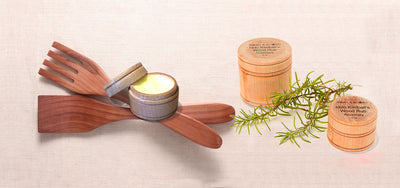- Continue Shopping
- Your Cart is Empty
7 Reasons Your Wooden Spoons Fall Apart

The wooden spoon is one of the most popular kitchen utensils. With frequent use and improper care, they will often warp, crack or splinter. To keep yours strong and safe for years of use, it’s helpful to identify some of the factors that could be causing early degradation or destruction.
Shoddy quality
When it comes to kitchen spoons the old adage ”you get what you pay for” has never been truer. Cheap wooden spoons are often mass-produced over seas using cheap wood and ignore the fine details that go into making high quality wooden spoons. If you want a spoon to last longer than a year, make sure you invest in one that uses a strong wood such as maple or cherry. Your best bet is a handcrafted wooden spoon that’s been made right here in the US by hardworking craftspeople.
Washing them in the dishwasher
One of the most common mistakes people make with wooden spoons is washing them in the dishwasher. Wood should never soak in large amounts of water for long periods of time. The harsh detergents and heat from the dishwasher will also start breaking down the quality and strength of the wood. Because of these damaging factors, you should always hand wash your spoon with warm water and mild soap.
You’re not drying it right
Just as the dishwasher can expose the wooden spoon to too much water, leaving a wooden spoon to air dry without wiping down the moisture will have a similar adverse affect. Once you’ve washed your spoon, be sure to dry it thoroughly using a dishtowel so that the fibers are unable to absorb any of the excess water.
You’ve never seasoned your spoon
When you get a wooden spoon, the first thing you should do is season it (preserve the wood) using natural mineral oil or one of the trusted natural wood preserving products on the market. This simple and inexpensive step adds a protective layer on your spoon, ensuring it will stand up to the heat, water and wear and tear of the kitchen. This also helps ward off unwanted bacteria. You’ll also want to re-season your spoon several times a year to keep that strong protective coat on the wood.
The wood fibers have grown soft and fuzzy
With repeated use, sometimes the wood can grow soft and fuzzy as the fibers get worn down. If you let this continue the quality of the spoon will most surely degrade. To avoid this all you have to do is grab some gentle sandpaper or steel wool and sand down the wood until you have a fresh layer. Make sure you keep the edges smooth and don’t over do it. You can also pick up a wood care rejuvenating kit. Once you’ve created a fresh new layer, be sure to season the spoon again to add back that protective layer.
It smells weird
While bad odors don’t really make wooden spoons fall apart, they can make it so unpleasant to use you may eventually throw it out. It’s also a sign that the spoon is not being properly cleaned or protected against bacteria, which will surely aid in its demise. To keep it smelling fresh and free of bacteria, simply treat it occasionally with a mixture of baking soda and water or find a natural wood cleaner.
You’re not using it right
We know it sounds odd. It’s a spoon right? But like any tool, a wooden spoon should be handled correctly and with care. If it’s often being used to do things it shouldn’t be doing, the quality of the wood can suffer. Generally, wooden spoons should be used to stir, gently mix, scoop and serve. If you’re using it as a makeshift power mixer, vigorously scraping the sides of pans with it’s edges, or using it to vent saucepans, the aggressive use can lead to cracks or general degradation. We’re not saying your wooden spoon can’t take it. A good wooden spoon is strong, reliable and is used for a variety of things. We’re just saying, be careful how you use it.






